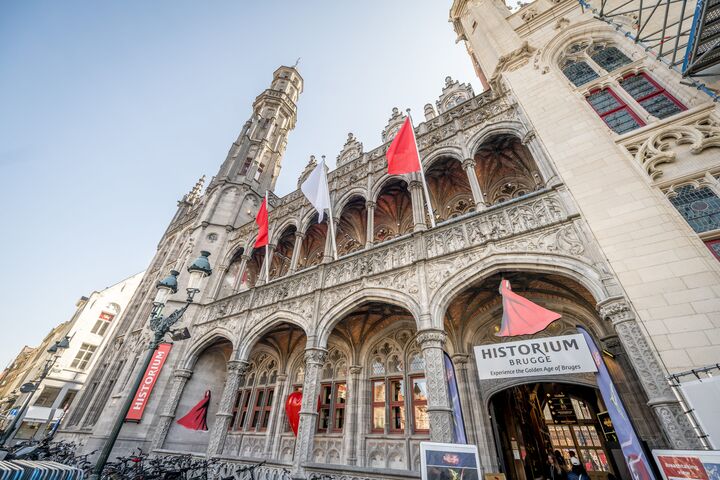The magnificent Bladelin Court houses several works of art associated with the rich history of the City Palace. The medallions of Lorenzo de’ Medici and Clarice Orsini are among the many eye-catching displays that can be admired there.
Medallions of Lorenzo de' Medici and Clarice Orsini
The two medallions in the patio garden of Bladelin Court are the epitome of Renaissance ornamentation. They are testimony to the presence of the world famous de' Medici family. The two tondos show the portraits of Clarice Orsini and her husband Lorenzo de' Medici. They were probably created on the occasion of their marriage, during the governorship of Tommaso Portinari. The emblem of the de’ Medici family with the ring and three ostrich feathers, is prominently displayed in the composition of the tondos.
Angel Couple by Laurent Delvaux
Commissioned by Archduke Charles Alexander of Lorraine, Laurent Delvaux sculpted the Angel Couple between 1761 and 1763. The archduke was governor of the Austrian Netherlands during the reign of Empress Maria Theresa of Austria. He purchased the statues for 18,000 Brabant Florins. They were originally intended for the court chapel in Brussels, but in 1794 the court chapel was dismantled during the French occupation. The Angel Couple ended up with the sculptor Gilles-Lambert Godecharle, who kept it in his studio until 1827. De Foere possibly bought the statues there, to place them in the classicist chapel of Bladelin Court. Four study models of the sculptures are kept in the Musée des Arts Décoratifs de Namur, the Musée Communale de Nivelles and in a private collection.
Stained glass windows by the studio of Jules Dobbelaere
They were designed and assembled in 1901 by the studio of Jules Dobbelaere (1859-1916) in Bruges. Jules Dobbelaere, who was born and raised in Bruges, learned the tricks of the trade from his father Henri Dobbelaere. After his father's death, he took over the studio at the age of twenty-six. He made stained glass windows for churches, monasteries and chapels in Belgium, but also made his mark on the international market. After the death of Jules Dobbelaere, there was no official successor to keep the studio on the right track. In 1918 a family member took over the studio, but it never again achieved the international success it had previously enjoyed.
Sister Gabrielle Claeys room
The Sister Gabrielle Claeys room is accessible via the former banking room and entrance hall. A central door in the interior wall hides a built-in closet. The walls are finished with room-high panelling or wall panelling containing paintings stretched on canvas. They consist of gilded frames with corner motifs depicting a swinging banderole and ears of wheat. The small paintings have flower garlands as the central motif, the large ones have round or oval medallions with island and seascapes.
Fifteenth-century beam keys
The fifteenth-century Burgundian beam keys show painted and carved coats of arms. They reinforced the owner’s position of authority and reflected political power dynamics. On many public buildings, squares and comital residences, the city’s arms served as recognizable eye catching features. In testimony to the presence of de’ Medici, we must not forget the beam keys in the banking room. The de’ Medici coat of arms is recognisable by the eight spheres with their motto "Semper," the three peacock feathers in a ring and the banderole. Philip the Good and Charles The Bold are identified on the other side by the necklace of the Order of the Golden Fleece and the emblem of the Duke of Burgundy with the flint stone.
Practical information
Accessibility
- Disabled people can contact the reception desk.




